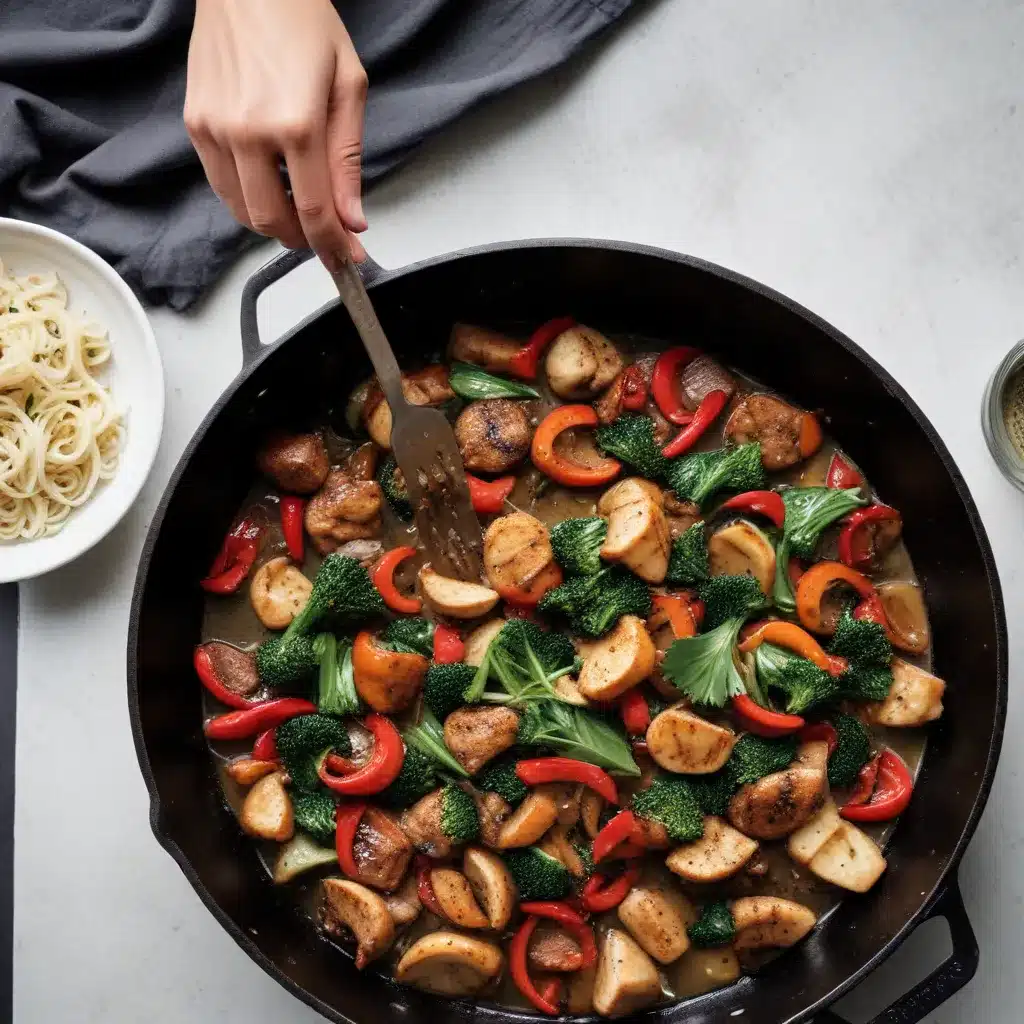
Mastering the Art of High-Heat Cooking
As a seasoned culinary professional, I’ve spent years honing my skills in the art of sautéing, pan-frying, and stir-frying. These high-heat cooking techniques are the foundation of many flavorful, crisp, and vibrant dishes – from classic Chinese stir-fries to elegant pan-seared entrees. In this comprehensive guide, I’ll share the secrets to mastering these essential cooking methods and elevating your meals to new heights.
The Importance of Proper Prep
Before diving into the cooking process, proper preparation is key. In the world of high-heat cooking, timing is everything, so having all your ingredients ready to go is crucial.
Prepare Your Proteins: Whether you’re working with tofu, tempeh, or meat, it’s important to ensure your proteins are prepped for optimal texture and flavor. For tofu or tempeh, be sure to press out any excess moisture and toss the cubes in a light coating of arrowroot powder or cornstarch. This will help them develop a delightfully crisp exterior when seared. For meats, gently pat them dry and season with a blend of spices, such as garlic powder, onion powder, and a pinch of salt and pepper.
Chop and Slice with Care: Cutting your vegetables into uniform, bite-sized pieces is essential for even cooking. Aim for thin, long slices or small, evenly-sized cubes, depending on the dish. This will help ensure all the ingredients cook at the same rate, resulting in a harmonious blend of textures and flavors.
Prepare Your Sauce: Having your sauce ready to go before you start cooking is a game-changer. Whisk together all the sauce ingredients – think soy sauce, rice vinegar, garlic, ginger, and a touch of sweetener – and have it on hand to quickly incorporate once your vegetables and proteins are seared.
Activate Your Thickener: To achieve that perfect, glossy sauce consistency, you’ll want to have a starch-based thickener at the ready. Mix a couple of teaspoons of arrowroot powder or cornstarch with a few tablespoons of water, and let it sit until you’re ready to add it to the pan.
Mastering High-Heat Techniques
Now that you’ve prepped all your ingredients, it’s time to put your culinary skills to the test. When it comes to sautéing, pan-frying, and stir-frying, proper pan selection and temperature control are crucial.
Sautéing
Sautéing is all about that delicate balance of caramelization and tender-crisp vegetables. Start by heating a large, heavy-bottomed skillet or sauté pan over medium-high heat. When the pan is hot, add a small amount of high-heat oil, such as avocado or grapeseed oil.
Working in batches if necessary, sauté your vegetables, taking care not to overcrowd the pan. The key is to allow the veggies to develop a slight char and caramelization on the edges, which will intensify their natural sweetness. Once the first batch is done, remove them from the pan and set aside, then repeat with the remaining vegetables.
Pan-Frying
Pan-frying is a fantastic technique for achieving a golden-brown, crispy crust on proteins like chicken, steak, or fish. Begin by heating a cast-iron or stainless steel skillet over medium-high to high heat. Once the pan is ripping hot, add a small amount of oil and carefully add your seasoned proteins.
Resist the urge to move the proteins around too much – let them sear and develop that delectable caramelized exterior. Flip the proteins only once, and continue cooking until they reach your desired level of doneness. Remember to adjust the heat as needed to prevent burning.
Stir-Frying
Stir-frying is the quintessential high-heat cooking method for creating lightning-fast, flavorful dishes. Start by heating a large wok or heavy-bottomed skillet over high heat. When the pan is ripping hot, add a small amount of oil and immediately add your vegetables, working in batches if necessary.
The key to stir-frying is to keep the food moving constantly, tossing and stirring to ensure even cooking. This quick, high-heat cooking method helps the vegetables retain their vibrant colors, crisp-tender texture, and bold flavors. Once the veggies are nearly cooked through, add your sauce and starch thickener, allowing the sauce to quickly thicken and coat the ingredients.
Incorporating Flavor-Packed Ingredients
While technique is essential, the right ingredients can take your sautéed, pan-fried, and stir-fried dishes to new levels of deliciousness.
Aromatics
Aromatics like garlic, ginger, and scallions are the flavor foundation of many Asian-inspired dishes. Sautéing or stir-frying these ingredients first helps to release their essential oils and add a fragrant base to your creations.
Sauces and Marinades
Crafting your own signature sauces and marinades can truly elevate your high-heat cooked meals. Explore bold flavors like tamari, rice vinegar, sesame oil, and honey to create a flavorful foundation for your proteins and vegetables.
Finishing Touches
Don’t forget the power of finishing touches! A drizzle of toasted sesame oil, a sprinkle of toasted nuts or seeds, or a fresh garnish of sliced scallions can all add that extra layer of flavor and texture to your dish.
Recipes to Inspire Your Culinary Adventures
Ready to put your newfound high-heat cooking skills to the test? Here are a few recipes to get you started:
- Indian-Chinese Broccoli Manchurian Stir-Fry
- Stir-Fried Brussels Sprouts with Ginger and Curry Leaves
- Paleo Chicken and Broccoli Stir-Fry
- Best-Ever Beef and Broccoli
By mastering the art of sautéing, pan-frying, and stir-frying, you’ll unlock a world of flavorful, healthy, and visually stunning meals. With a little practice and the right techniques, you’ll be whipping up restaurant-quality dishes right in your own kitchen. Happy cooking, Kitchen Warriors!


